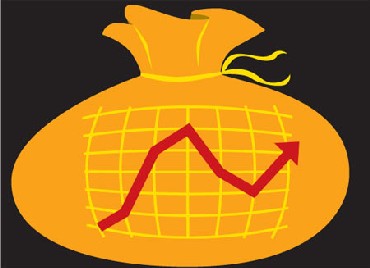Global financial services major Barclays Capital said on Monday India's economy is likely to register an annual growth rate of 7-8 per cent, below the country's full potential, in next 3-5 years.
"We expect India to register growth of 7-8 per cent over the next 3-5 years, depending on the global growth cycle and the absence of any large-scale weather aberrations. While this appears a decent growth rate, it is lower than India's growth potential," Barclays Capital said in its issue of 'Emerging Markets Research'.
According to the financial services firm, India's growth pattern remains skewed towards the services sector and is heavily dependent on domestic consumption, which it said, raises the possibility that the imbalance between the services and other sectors may widen even further.
. . .
Barclays pegs India's growth at 7-8%
The services sector contributes to around 55 per cent of the country's gross domestic product.
According to Barclays, over the next five years, infrastructure bottlenecks, normally blamed for holding the country's growth back, are expected to ease in certain areas.
"We expect this to occur in the areas of financial, urban and human capital infrastructure, which are likely to be of greatest benefit to the services industry," it said.
The firm, however, added that absence of large-scale improvements in basic and rural infrastructure would mean that agriculture and manufacturing sectors are likely to continue to be hampered by weak productivity growth and capacity constraints.
. . .
Barclays pegs India's growth at 7-8%
While Barclays has projected 7-8 per cent annual average growth for India, the Planning Commission is looking at achieving 9 per cent annual growth during the 12th Five-Year Plan (2012-17).
The economy is expected to end the current 11th Plan (2007-12) with an average annual growth of 8.1 per cent, below the original estimate of 9 per cent.
"While India's engagement with the global economy has increased, its leverage to global growth remains relatively low.
"Even in an environment of generally subdued global economic activity, we think India should broadly be able to remain on its own growth path if it can manage its domestic economy well," Barclays said.
. . .
Barclays pegs India's growth at 7-8%
Image: A worker counts US dollar bills at a money changer in Manila.Photographs: Romeo Ranoco/Reuters
It, however, warned that rise in commodity prices could dent India's relative competitiveness in exports.
The report termed the bottlenecks hindering the country's economic growth as 'self-inflicted'.
". . .the main approach in recent years has been to stoke demand through wage-generating programmes, rather than implement policies that could improve productivity and longer-term supply dynamics.
"The situation has been aggravated by a lack of political consensus and at times short-term policy measures designed to satisfy current needs over the future," Barclays said, adding that it does not foresee any major changes in next year or two.
. . .
Barclays pegs India's growth at 7-8%
The report said that while nominal income in the country is likely to continue rising, the income disparity between rural and urban areas is likely to widen further, reflecting the widening gap in productivity.
"The government's expansionary fiscal policy attempts to combat this trend by trying to support rural income. But there is little focus on productivity growth, which could be more effective," it said.
Barclays further said that rising income disparity can lead to asset inflation as wealth becomes more concentrated.
. . .
Barclays pegs India's growth at 7-8%
Image: Harish, 11, a school boy uses a laptop provided under the One Laptop Per Child project.Photographs: Danish Siddiqui/Reuters
". . . in the face of constrained supply and sticky demand, high capacity utilisation and low productivity growth, the manufacturing and agriculture sectors are likely to experience sustained inflationary pressures," it said, adding that the manufacturing sector particularly remained vulnerable to commodity price shocks.
"For the agriculture sector, an absence of decisive measures to boost productivity implies continued sub-optimal growth.
"The extent of price increases is likely to be determined largely by weather conditions and fiscal support through government policies," it added.







article